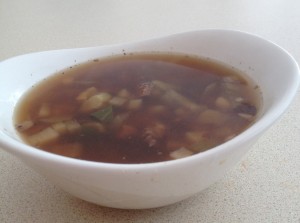
A bowl of this soup is suitable for an induction diet
As I’ve remarked, I’m currently following a ketogenic diet (also known as Low Carbohydrate). Since Calorie Restriction did not work for me, I’m going back to what I know.
For many people, low carbohydrate means lots of bacon and very few vegetables. That simply isn’t true. It does mean that starchy vegetables are out during the time you are losing weight (vegetables like beets, potatoes), but eventually they can be added back in on a limited basis. Grains are also out during weight loss.
But other vegetables are encouraged as well as some lower carbohydrate fruits (berries mostly) which can be added in later in the diet. A ketogenic diet is about finding the set point where your body is burning fat and allowing it to do that until you are at your goal. While my ketogenic diet starts at 20 grams of net carbohydrates a week, it will go up as I progress.
Most people starting a low ketogenic diet work with meats, hard cheeses and salads for the first few weeks/months of this way of eating. Since I still want to continue following a local/seasonal way of eating, that is harder for me to do. Right now, salad greens still haven’t grown, and I’m still eating root vegetables and dark greens.
Last week, I made a beef bone stock. It’s about 2 days of simmering to extract all the goodness from the bones. After making (and straining) it, the stock sat in my refrigerator until the next weekend when I turned it into a low carbohydrate soup that actually is fine for my induction diet.
I used a variety of root vegetables and green leafy vegetables as well as some items I have dehydrated. The result is a soup that comes out to 3.4 grams of net carbohydrates per each 12 ounce serving. (See that picture at the top, that is 1 serving).
Because I made my own stock, the total amount of carbohydrates is different than if you choose to purchase a beef stock. My stock was made from beef bones, water and less than a cup of cider vinegar (which promotes extraction of the minerals). Because my stock was made from bones and allowed to simmer for almost 48 hours, this soup is very high in minerals as well. Much higher than a store-bought soup.
When I made this recipe, I usually just wing it, but today I took out my trusty food scale and weighed everything in grams. I then went to the USDA Nutrition Database and got the exact nutrient numbers for each ingredient.
Recipe for Low Carb Beef Vegetable Soup
Makes 24 (12 ounce) servings
- 24 Cups (5,443.2 grams) Beef Stock (preferably home-made)
- 1 Med (340 grams) Turnip (finely chopped)
- 2 Each (415 grams) Daikon Radish (finely chopped)
- 2 Each (362 grams) Baby Bok Choy (finely chopped)
- 1 Large (441 grams) Onion
- 1 Cup (9 grams) Dried Portabello Mushrooms Or (3 cups fresh) (Finely chopped)
- 1/2 Cup (32.9 grams) Dried Zucchini (or 1 1/2 cups fresh) (Finely chopped)
- 8 ounces (192 grams) Crimini Mushrooms (finely chopped)
- 2 1/2 pounds (1,075 grams) Beef Stew Meat – cut into small pieces
- 1 T Oil (I used bacon fat, but you can use lard, tallow, olive oil or coconut oil)
- Salt and Pepper to taste
- Have all the stock going in a large stockpot. Add in the Turnip, Daikon Radish, Bok Choy.
- In a large frying pan, add in the fat. When its hot, add small amounts of onion and cook until browned and soft. When done, put each batch into the stockpot.
- When the onions are completely in the stock pot, add the crimini mushrooms in small batches into the frying pan and again, cook until soft and slightly brown. When done, add each batch into the stockpot
- When the mushrooms are completely in the stockpot, add the stew meat in small batches. Let them brown, but don’t cook them completely. Add each batch to the stock pot.
- Bring the stockpot to a boil, then reduce to a simmer. Let it cook for at least 2-3 hours until the meat and vegetables are throughly cooked. Add Salt and Pepper to taste.
Yes, I make big amounts, but the soup will also freeze well. So make a big batch and enjoy!
Related articles
- Soup Stock-How Important is it to Make Your Own? VERY! (goodnutritioninanutshell.wordpress.com)
- Recipe: Beef Bone Broth (realfoodforager.com)
- The “Cumulative Time” Approach for Making Stock (thehealthyhomeeconomist.com)
- Reader Questions: Bone Broth (nourishedkitchen.com)
